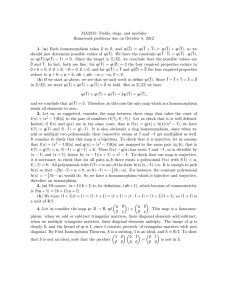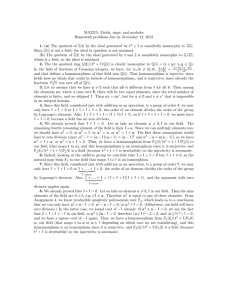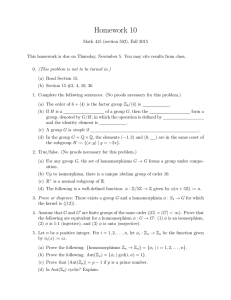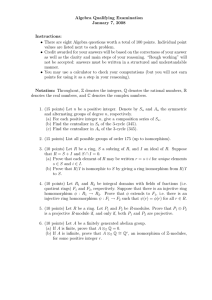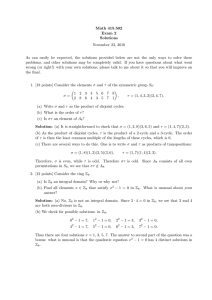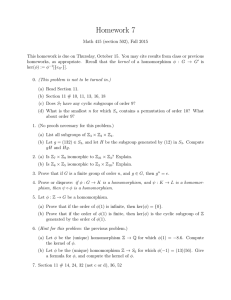Mathematics 2215: Rings, fields and modules Homework exercise sheet 2
advertisement
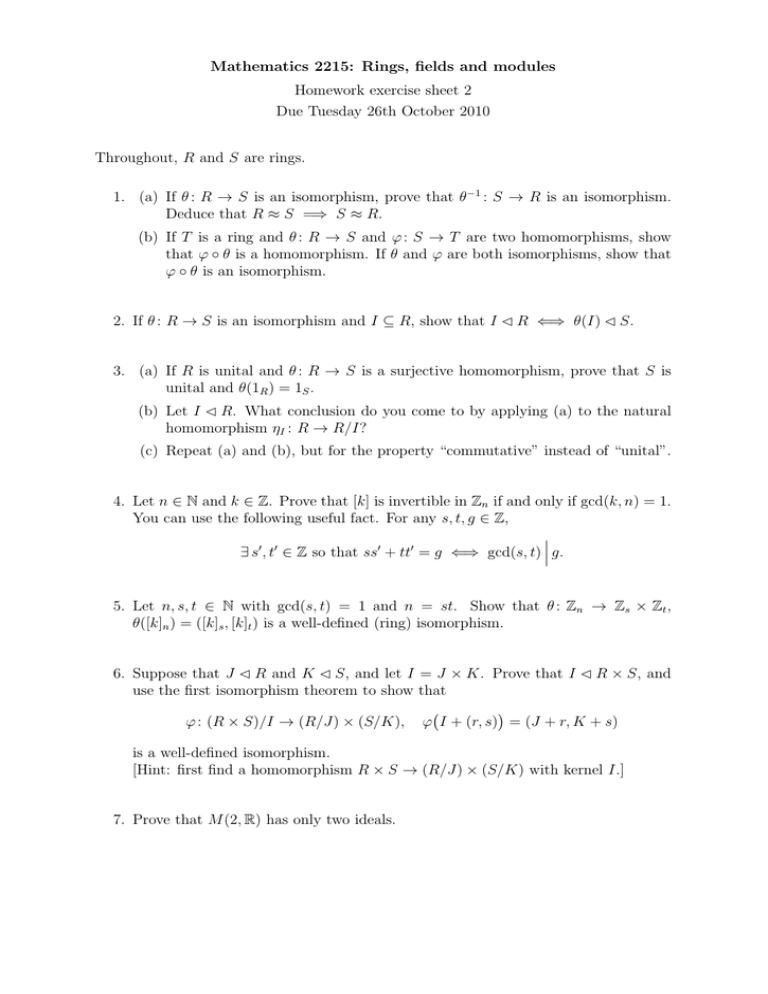
Mathematics 2215: Rings, fields and modules Homework exercise sheet 2 Due Tuesday 26th October 2010 Throughout, R and S are rings. 1. (a) If θ : R → S is an isomorphism, prove that θ−1 : S → R is an isomorphism. Deduce that R ≈ S =⇒ S ≈ R. (b) If T is a ring and θ : R → S and ϕ : S → T are two homomorphisms, show that ϕ ◦ θ is a homomorphism. If θ and ϕ are both isomorphisms, show that ϕ ◦ θ is an isomorphism. 2. If θ : R → S is an isomorphism and I ⊆ R, show that I C R ⇐⇒ θ(I) C S. 3. (a) If R is unital and θ : R → S is a surjective homomorphism, prove that S is unital and θ(1R ) = 1S . (b) Let I C R. What conclusion do you come to by applying (a) to the natural homomorphism ηI : R → R/I? (c) Repeat (a) and (b), but for the property “commutative” instead of “unital”. 4. Let n ∈ N and k ∈ Z. Prove that [k] is invertible in Zn if and only if gcd(k, n) = 1. You can use the following useful fact. For any s, t, g ∈ Z, ∃ s0 , t0 ∈ Z so that ss0 + tt0 = g ⇐⇒ gcd(s, t) g. 5. Let n, s, t ∈ N with gcd(s, t) = 1 and n = st. Show that θ : Zn → Zs × Zt , θ([k]n ) = ([k]s , [k]t ) is a well-defined (ring) isomorphism. 6. Suppose that J C R and K C S, and let I = J × K. Prove that I C R × S, and use the first isomorphism theorem to show that ϕ : (R × S)/I → (R/J) × (S/K), ϕ I + (r, s) = (J + r, K + s) is a well-defined isomorphism. [Hint: first find a homomorphism R × S → (R/J) × (S/K) with kernel I.] 7. Prove that M (2, R) has only two ideals. Optional questions for enthusiasts 8. If R and S are unital and θ : R → S is an injective homomorphism, must we have θ(1R ) = 1S ? Give a proof or a counterexample. 9. What are the ideals of a zero ring? 10. Find rings R and S and a group isomorphism θ : (R, +) → (S, +) which is not a ring isomorphism. 11. Let θ : R → S be a homomorphism and let I be an ideal of R. (a) Show that the formula θI : R/I → S, θI (I + x) = θ(x) gives a well-defined mapping if and only if I ⊆ ker θ. (b) Show that if θI is well-defined, then it is a homomorphism. (c) Show that θI is an injective homomorphism if and only if I = ker θ. (d) Show that θI is an isomorphism if and only if θ is surjective and I = ker θ. 12. (a) If R and S are unital, prove that a set I ⊆ R × S is an ideal in R × S if and only if I = J × K for some J C R and some K C S. (b) Show that we do need to assume that R and S are unital for the statement in (a) to be true. That is, give an example of two rings R and S and an ideal I C R × S which is not equal to J × K where J C R and K C S. 2
